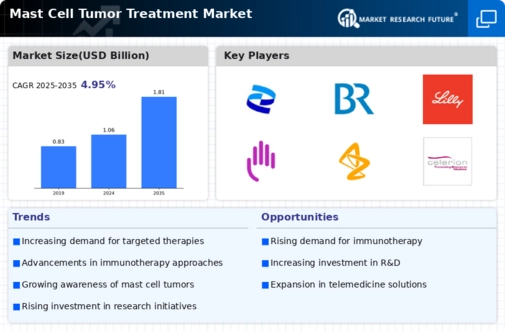Growing Awareness Among Pet Owners
Growing awareness among pet owners regarding mast cell tumors is a crucial driver for the Mast Cell Tumor Treatment Market. Educational campaigns and increased access to information have empowered pet owners to recognize symptoms and seek timely veterinary intervention. This heightened awareness is likely to lead to earlier diagnoses, which can significantly improve treatment outcomes. As more pet owners become informed about the risks associated with mast cell tumors, the demand for effective treatment options is expected to rise. Consequently, this trend may contribute to the expansion of the Mast Cell Tumor Treatment Market, as veterinary clinics adapt to meet the needs of a more informed clientele.
Advancements in Veterinary Oncology
Advancements in veterinary oncology are significantly influencing the Mast Cell Tumor Treatment Market. Innovations in treatment modalities, including targeted therapies and immunotherapies, are becoming increasingly available. These advancements not only improve treatment outcomes but also enhance the quality of life for affected animals. For instance, the introduction of novel chemotherapeutic agents has shown promising results in clinical trials, leading to a potential increase in market share for companies that invest in research and development. As veterinary professionals become more adept at utilizing these advanced treatments, the Mast Cell Tumor Treatment Market is expected to experience substantial growth, driven by the demand for cutting-edge solutions.
Increase in Veterinary Expenditures
The increase in veterinary expenditures is a significant factor influencing the Mast Cell Tumor Treatment Market. As pet ownership continues to rise, so does the willingness of pet owners to invest in their animals' health. Reports indicate that veterinary spending has seen a steady increase, with many owners prioritizing advanced medical treatments for their pets. This trend is particularly evident in the treatment of serious conditions such as mast cell tumors, where owners are more inclined to pursue comprehensive care options. Consequently, this increase in veterinary expenditures is likely to bolster the Mast Cell Tumor Treatment Market, as veterinary practices expand their services to accommodate the growing demand for specialized treatments.
Rising Incidence of Mast Cell Tumors
The increasing incidence of mast cell tumors is a notable driver for the Mast Cell Tumor Treatment Market. Recent data indicates that these tumors are among the most common skin tumors in dogs, with a prevalence rate that appears to be rising. This trend may be attributed to factors such as environmental influences and genetic predispositions. As awareness of mast cell tumors grows, pet owners are more likely to seek veterinary care, leading to a higher demand for effective treatment options. Consequently, this rising incidence is likely to stimulate growth in the Mast Cell Tumor Treatment Market, as veterinary practices expand their offerings to include advanced therapies and diagnostic tools.
Regulatory Support for Veterinary Treatments
Regulatory support for veterinary treatments is emerging as a vital driver for the Mast Cell Tumor Treatment Market. Regulatory bodies are increasingly recognizing the importance of developing and approving new therapies for veterinary use. This support can facilitate faster approval processes for innovative treatments, thereby encouraging pharmaceutical companies to invest in research and development. As a result, the availability of new and effective treatment options for mast cell tumors is likely to increase, which could enhance competition within the Mast Cell Tumor Treatment Market. This regulatory environment may also foster collaborations between veterinary professionals and researchers, further driving advancements in treatment methodologies.

















Leave a Comment